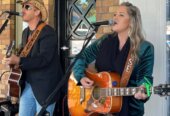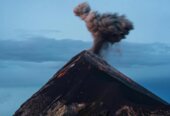It’s Saturday night and I am working. Sitting here with my laptop and music playing through headphones while my housemates rightfully relax with a movie, I am preparing for my trip to the Canary Islands next week where I will be working in a disaster zone.
The destination is part of the Cumbre Vieja volcanic ridge on the island of La Palma, where intensely hot, powerful lava flows erupted from a new volcanic vent and covered a populated area.
Tonight, I am creating a digital map consisting of layers that show details of the lava flow field that covered about 12 square kilometres, and satellite images showing the buildings that were damaged. Well, showing the partial buildings remaining around the edges of the lava flow. With around 1,300 homes destroyed, many of these are buried below solid rock that averages 12 metre thick, reaching a maximum thickness of 70 metres, and therefore are not visible. When I am in the field this work will assist me in accurately locating where I am, and I can tag important information and observations using GPS into one neat package. It will also give us a bird’s eye view of the top of the lava flow and buildings that tower around us. This provides important context to what we are seeing on the ground.
With special permission, I will be working around the edges of the lava flow, examining the damage it has caused with the hope of gaining insight into how future eruptions will wreak havoc on populated areas and infrastructure. I recently wrote a column on the Auckland Volcanic Field; this eruption is a good example of what an eruption in our most populated city could look like.
This is a sensitive area to enter. While lava flows are incredible to work on, this was a once thriving neighbourhood full of families, friends, children. It deserves respect and compassion. With little notice, around 8000 people evacuated as the volcano roared to life for 85 days, the loud eruption an overbearing presence as people waited to hear if their homes and businesses were still standing.
This is also a hazardous area. The solid lava is very glassy and sharp, it will still be very hot, it is riddled with tubes and areas that could collapse, and some areas around the flow contain deadly levels of gas that are still seeping out of the volcanic ground. None of this is taken lightly, safety is always the priority.
Why am I doing this work? Because when a volcano erupts in a populated area people naturally want as much information as they can get. The information I collect in the field with my colleagues will be compared to data acquired by satellites in space during the eruption to see what we can accurately identify remotely, as well as making comparisons to the properties of the lava flow as it progressed. It’s not as simple as ‘if the lava touches your house, it’s gone.’ Each study like this is one piece in the global puzzle that is understanding volcanoes, their eruptions, how they impact areas, and how we can help people prepare and respond.









